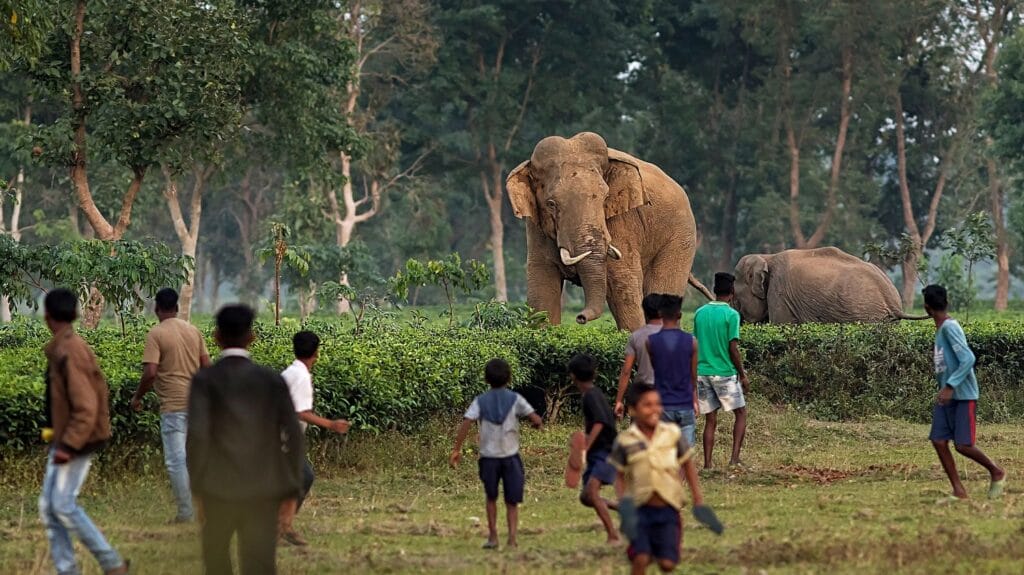Introduction
Human-elephant conflicts (HEC) have become a pressing issue in Assam, reflecting a troubling trend that poses significant challenges to both human populations and wildlife conservation. Over the past five years, the state has experienced a notable rise in fatalities due to elephant attacks, ranking second only to Odisha in human fatalities from HEC in India. This increase in conflict can be attributed to various factors, including habitat encroachment, agricultural expansion, and inadequate responses from authorities. To address this alarming trend, it is crucial to explore the underlying causes and implement effective measures for mitigation.
Factors Contributing to Rising Human-Elephant Conflicts

Habitat Encroachment
One of the primary factors contributing to the rise in human-elephant conflicts in Assam is habitat encroachment. As human populations grow and agricultural land expands, elephants are increasingly forced into smaller habitats, leading them to venture into human settlements in search of food and space. This overlap often results in direct confrontations, endangering both human lives and elephant populations.
Agricultural Practices
Elephants are known to raid crops, particularly paddy fields, which disrupts the livelihoods of local farmers. The loss of crops due to elephant raids leads to significant economic hardships for affected families, fostering resentment towards elephants and prompting retaliation. As agricultural activities expand into elephant corridors, conflicts are likely to increase.
Ineffective Mitigation Measures
Despite the central government’s funding for conflict mitigation, there has been inadequate response from the forest department and local authorities. Slow and ineffective actions to manage these conflicts exacerbate the situation, leading to rising fatalities and property damage. The lack of timely intervention has resulted in a perceived disregard for both human safety and wildlife conservation.
Measures for Mitigation
Strengthening Forest Management
To effectively mitigate human-elephant conflicts, there is a pressing need for improved forest management practices. This includes enhancing the monitoring of elephant movements, implementing effective barrier systems to deter elephants from entering human settlements, and maintaining clear migratory corridors to facilitate safe passage for elephants.
Community Awareness Programs
Raising awareness among local communities about the importance of elephant conservation and the ecological significance of maintaining healthy wildlife populations can help foster coexistence. Community engagement initiatives can empower residents to adopt non-lethal measures for managing elephant encounters and reduce retaliation against these animals.
Quick Response Mechanisms
Establishing a rapid response team that can promptly address incidents of elephant encroachment can significantly reduce the impact of conflicts. This team should be equipped with trained personnel who can safely guide elephants back to their habitats, minimizing the risk to human life and property.
Leveraging Technology
The use of technology, such as drone surveillance and SCADA systems, can enhance monitoring capabilities and early warning systems. These technologies can provide real-time data on elephant movements and potential conflicts, enabling timely interventions and reducing human-elephant encounters.
Conclusion
The increasing trend of human-elephant conflicts in Assam poses a significant threat to both human safety and wildlife conservation. Factors such as habitat encroachment, agricultural expansion, and ineffective management contribute to this rising toll of elephant attacks. To mitigate these conflicts, it is essential to implement comprehensive measures that focus on strengthening forest management, raising community awareness, establishing quick response mechanisms, and leveraging technology.
Way Forward
A multi-faceted approach is necessary to address human-elephant conflicts effectively. Collaboration between government agencies, local communities, and conservation organizations can create a sustainable framework for coexistence. By prioritizing the protection of both human lives and elephant populations, Assam can pave the way for a harmonious relationship between wildlife and local communities, ensuring the preservation of its rich biodiversity for future generations.
Attempt the questions:
Here are some Public Service Commission (PSC) standard questions:
- Analyze the socio-economic impact of human-elephant conflicts on local communities in Assam. How do these conflicts affect agriculture and the livelihoods of affected families?
- Evaluate the effectiveness of current government initiatives, such as the Gaj Yatra and Plan Bee, in addressing human-elephant conflicts in Assam. What further actions are necessary to protect both human and elephant populations?
- Compare the human-elephant conflict situation in Assam with that of Odisha. What lessons can be learned from the experiences of these states to improve conflict management strategies?
- Critically assess the role of the forest department in managing human-elephant conflicts in Assam. What challenges do they face, and how can their response be improved to better address the situation?
- What are the ecological implications of human-elephant conflicts in Assam, and how do these conflicts influence conservation efforts in the region?

